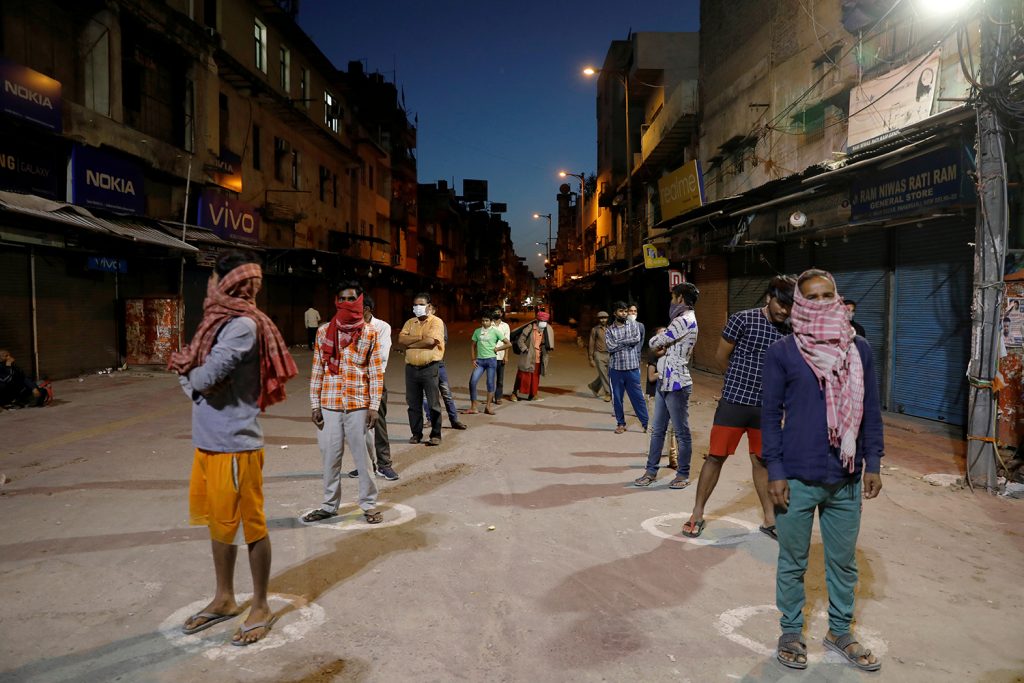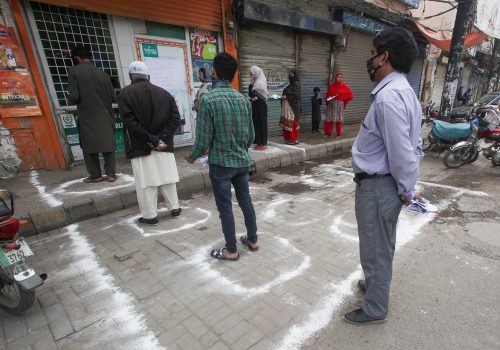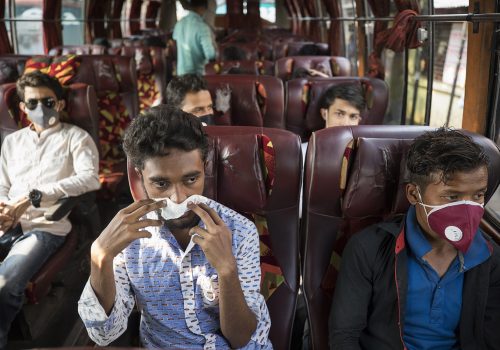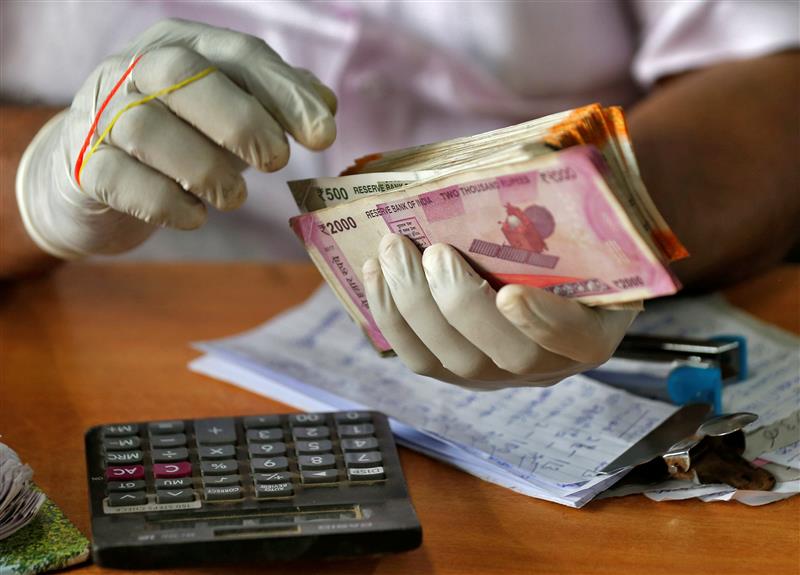With more than 3,000 cases of coronavirus already reported, the countries of South Asia have already begun to put in place mandatory quarantines and lockdowns to slow the spread of the virus and prepare their health care systems for potential overload. As is the case in other countries around the world, these social distancing measures have sent markets reeling and threaten to slow or completely halt economic activity.
In anticipation of this crisis, governments in India, Pakistan, and Bangladesh are preparing or have already passed massive stimulus packages aimed at providing support for the most economically vulnerable in their countries and emergency funding for businesses to weather the current shutdowns.
Experts from the Atlantic Council’s South Asia Center analyze the current efforts of these governments and the potential economic consequences of the coronavirus pandemic on South Asia:
INDIA
Ketki Bhagwati, senior advisor for the South Asia Center:
“At a mere 1 percent of gross domestic product (GDP), the Indian government’s stimulus package, to provide a safety net to daily wage laborers displaced or unemployed by the coronavirus pandemic, is paltry. The Organization for Economic Cooperation and Development (OECD) governments in comparison are considering spending between four to five percent of GDP (the United States’ initial rescue package was 10 percent of GDP), ranging from cash support to food subsidies, to save their distressed populations from the economic repercussions of the virus. India’s response to the pandemic appears to be hamstrung by angst over fiscal targets and lower GDP numbers following the contiguous double economic shocks of demonetization and the goods and services tax (GST). In the absence of much wider deficit spending to save livelihoods, the Indian government will fail to avert the crippling effects of resulting demand repercussions that could deepen social and recessionary pressures.
“Speed and efficacy in the delivery of targeted interventions to those it is intended to reach will also be critical. The constraints of an already overburdened and inefficient public delivery system are well known. The private sector can augment the Government’s relief efforts through their Corporate Social Responsibility (CSR) budgets and other remedial actions for which they should be rewarded with tax incentives. The Reserve Bank of India has stepped in expeditiously to relieve the distress of small enterprises, which support the majority of jobs in the country’s vast informal economy. However, cutting interest rates and a three-month moratorium on loan repayments is likely to provide only interim relief. The sequel to the government’s stimulus will inevitably be debt restructuring by banks for the long-term survival of these businesses.”
Safiya Ghori-Ahmad, nonresident senior fellow for the South Asia Center:
“Last week, the Indian government announced an economic stimulus package worth $1.7 trillion rupees ($22.5 billion) in aid designed to help low-income families with direct cash transfers, food assistance, employment aid to farmers, and health insurance. Shortly thereafter, the Reserve Bank of India slashed interest rates in an effort to counter the economic fallout.
“The stimulus package was announced after Prime Minister Narendra Modi instituted a twenty-one-day lockdown to mitigate the COVID-19 outbreak in India. The sudden lockdown order resulted in thousands of migrant workers in India’s densely packed cities rushing back home to their villages, many by foot and with scarce food.
“While the stimulus package will assist almost 800 million people, these measures are not enough. Based on global trends, India will likely experience a spike in COVID-19 cases over the next few weeks. Moreover, social distancing will likely be more difficult in India than in, say, the United States, due to the higher proportion of communal living arrangements and population density.
“Accordingly, unless the government takes additional actions, the already underfunded medical system will be quickly overburdened. Learning from the cautionary Italian and US experiences, the Indian government should immediately increase procurement of healthcare equipment.
“While the India government may be considering longer term business-focused relief, it will be important to provide tax incentives for export-oriented industries and support for tourism, airlines, and small businesses across all sectors.
“Even before the pandemic struck, the Indian economy was struggling. Without additional efforts, India’s struggles—medical and economic—are likely to get much worst before they get better.”
Ridhika Batra, vice president of corporate affairs, Mahindra Group-Americas:
“Investment and consumption demand have languished as the Indian economy experienced a prolonged slowdown over the past few quarters. The Government of India has undertaken a number of measures to stimulate the economy, but the COVID-19 pandemic now significantly impacts the future economic outlook and makes recovery efforts extremely difficult in the medium term.
“The outbreak continues to severely disrupt both demand and supply side elements. India is already among the top fifteen countries affected by a general manufacturing slowdown in China caused by the COVID-19 outbreak. On the supply side, industrial sectors such as automobiles, pharmaceuticals, electronics, and chemical products are facing imminent raw material and component shortages. According to United Nations Conference on Trade and Development, India’s trade impact due to coronavirus outbreak could total approximately $348 million. Domestic industry now faces cross-sector disruption—the overall trade impact is estimated to total $129 million for the chemical sector, $64 million for the textiles and apparel industry, $34 million for the automotive sector, $27 million for metal and metal products, and $12 million in electrical machinery.
“Given the challenges that businesses across sectors are facing, the Indian economy will likely experience further diminished growth during the last quarter of the current fiscal year (FY). Should the spread of COVID-19 continue, subdued growth may continue through the first quarter of FY 20-21. But the eventual economic impact of the COVID-19 outbreak will likely vary depending on its severity. The Asian Development Bank (ADB) estimates that the outbreak could cost the Indian economy between $387 million and $29.9 billion in personal consumption losses, with variation accounting for hypothetical best-case, moderate-case, worse-case, and worst-case scenarios.
“Given the human and economic toll COVID-19 threatens to impose, industry must step up and, in many cases, is already leading efforts to manufacture contingency supplies. Going forward, the government must maintain liquidity at surplus levels in short term, institutionalize policies to ensure adequate spending to strengthen public health systems and address the acute health demands arising out of the COVID-19 outbreak in the medium term, and diversify India’s supply chain dependence on china in long term.”
PAKISTAN
Uzair Younus, nonresident senior fellow for the South Asia Center:
“These are extraordinary times. Economies all over the world, including Pakistan, have come to a screeching halt. An economy that was only just recovering from an external crisis that saw the country go back to the International Monetary Fund (IMF) for another bailout has now been dealt a body blow whose impact is unimaginable. During every major economic crisis in Pakistan—and there have been several of them—the wheels of the informal economy have chugged along. Today, the informal sector stands to lose the most, particularly the tens of millions of workers who rely on this cash-based sector to provide them with the bare-minimum income required to meet their daily needs.”
Read more from Younus’ latest piece:
Kalsoom Lakhani, nonresident senior fellow for the South Asia Center:
“The COVID-19 pandemic has forced us all to hit pause globally, and that has had an immediate impact on jobs and livelihoods. In Pakistan, which was already facing an economic crisis with the currency devaluation and rising inflation, most businesses are at a standstill. While the Pakistan government has announced a financial stimulus package, the efforts are majorly targeted towards large businesses and industries, including those in the export sector. While this is certainly needed, as are efforts to provide direct cash support to households, the country’s growing technology and startup sector has been ignored.
“While the startup space in Pakistan is small, it is growing, and entrepreneurs are and can be the engines for job creation and growth in the country. Currently, the mobility sector—one of the most exciting sectors in Pakistan—has been paused, with players like Airlift (which recently raised $12 million in their Series A round) and Bykea (a high-growth on-demand for motorbikes startup) suspending their operations. Startups operating in the gig economy, like GharPar (on-demand for beauticians) and Mauqa (on-demand for household help) have similarly had to pause their operations, and while these companies are valiantly trying to keep paying their workforce—many of whom come from lower-income backgrounds—there should be financial packages, grants, or bridge financing provided by the government that can help keep these companies afloat and their employees paid in the interim.
“In the long-term, these startups and companies like them will be the lifeblood of job creation and the future economy (as well as the future of work), and if the government doesn’t provide financial packages to support them now, they will die before the pandemic is over.”
BANGLADESH
Dr. Ali Riaz, nonresident senior fellow for the South Asia Center:
“COVID-19 is likely to have significant impacts on the Bangladeshi economy because it comes at a time when several major indicators of the economy were already in a downward slope. Before the pandemic, economists warned that the country’s “macro economy was under pressure more than at any time in the past ten years.” The government’s denial of the extent of community transmission, underestimating the scale of the pandemic in the country, the trust deficit between the citizens and the government, poor health infrastructure, and lack of a comprehensive strategy to deal with the public health crisis will exacerbate the situation. The Asian Development Bank (ADB) has estimated that Bangladesh will lose about 1.1 percent of its GDP in the worst-case scenario if the outbreak lasts six months. This means that $3.02 billion from Bangladesh’s economy may be lost. Additionally, a global economic downturn may cost Bangladesh 894,930 jobs. Economists estimate that 40 percent of the total $310 billion economy will be exposed to the risks of the pandemic. The Bangladesh economy’s reliance on remittances, export-oriented Readymade Garments (RMG) sector, and close trading connections with China make it very vulnerable.
“Prime Minister Sheikh Hasina has declared a stimulus package which falls short of addressing the potential impacts on low- and middle-income citizens. The package offers Tk 5,000 crore ($59 million) to export-oriented industries, primarily the RMG sector, with the condition that it can only disbursed in the form of salaries and wages for employees and workers of the industries. The package’s skewed focus is likely to benefit a small number of people and leave the most vulnerable segments of society behind. Unfortunately, the package does not include any other concrete steps to address low- and middle-income citizens. The promises to strengthen existing safety net programs such as Vulnerable Group Development (VGD) and Vulnerable Group Feeding (VGF) are inadequate.
“The government’s actions thus far are halfhearted and piece-meal at its best and negligent at its worst. These are not likely to benefit the most affected. The government must set it priority in earnest and act expeditiously. It should consider ways to ensure that money reaches the people who need it most. It is also imperative that these measures are administered with transparency and accountability which, unfortunately, the government sorely lacks.”
Rudabeh Shahid, nonresident senior fellow for the South Asia Center and Irfan Nooruddin, director of the South Asia Center:
“Bangladesh has a health crisis in the making. The lack of preparation in the United States and Europe that has spawned the ongoing crisis there still exceeds the preparedness of developing countries such as Bangladesh, which will have to battle the COVID-19 pandemic with limited financial resources and a legacy of poor healthcare infrastructure, especially for the urban poor. Already one of the most densely populated countries in the world, Bangladesh also has thousands of stateless Rohingya housed in sprawling refugee camps in the southeastern region of the country, in conditions prime for rapid spread. Given its proximity to China and a large migrant population living in severely affected countries such as Italy, Bangladesh’s Ministry of Health and Family Welfare should have taken preventative measures when the Chinese government first shared news of the deadly virus. Unfortunately, precious time was squandered.
Read more from the latest piece:
“Policymakers in Bangladesh should gear up in anticipation of a deterioration of the situation. While the Asian Development Bank (ADB) has promised a $6.5 billion package to address the immediate needs of developing member countries (DMCs), and India’s Prime Minister Narendra Modi has pledged $10 million toward a special emergency fund to set up a rapid response team for the South Asian Association for Regional Cooperation (SAARC), Bangladesh will have to face this battle largely on its own. Over the past ten days, the South Asia Center has consulted broadly with public health professionals and social scientists who study Bangladesh.”
Further reading:
Event:
Image: People stand apart in a line to receive free food being distributed on a street during a 21-day nationwide lockdown to limit the spreading of coronavirus disease (COVID-19), in New Delhi, India March 30, 2020. REUTERS/Anushree Fadnavis



